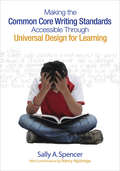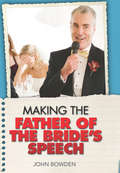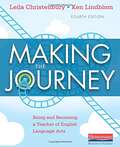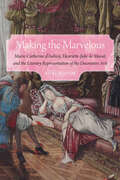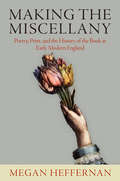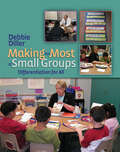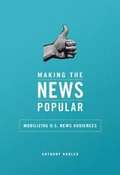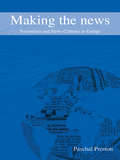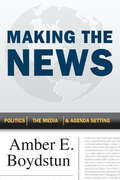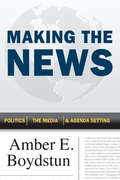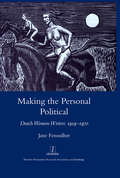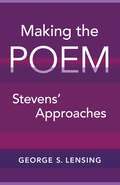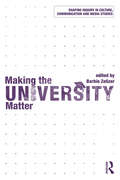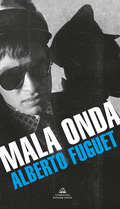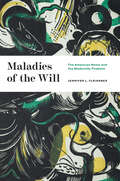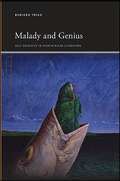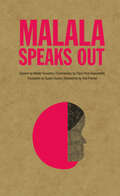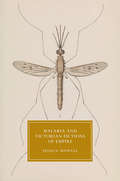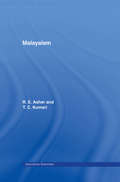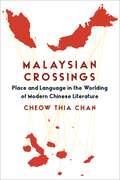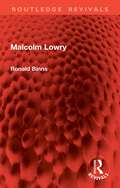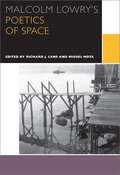- Table View
- List View
Making the Common Core Writing Standards Accessible Through Universal Design for Learning
by Sally A. SpencerUnlock hidden writing skills in all learners through UDL! The Common Core State Standards (CCSS) for writing are promising but present a host of challenges in implementation, especially for struggling students. In this valuable resource, Sally A. Spencer demonstrates the potential of Universal Design for Learning (UDL) as a framework for making the CCSS writing and language standards accessible to all kids. Educators who utilize these strategies will know: How to leverage the strengths of students to optimize writing instruction and overcome their weaknesses The ways UDL can minimize the roadblocks in CCSS implementation How to - and how not to - use technology to teach writing and language conventions With dozens of classroom-ready activities, resources for further reading, and reproducibles, this easy-to-use guide will help you make all students proficient writers. "This is the ultimate guide to successful UDL implementation, with ready-to- use activities and resources that support the Common Core Writing Standards for students in all grades. Energize your classroom with this practical guide that engages all learners and helps you plan your lessons with ease. This is a must-have for all teachers!" —Renee Bernhardt, Ed.S Curriculum and Instruction-Learning Support Cherokee County School District Canton, GA "This is one of the most relatable and relevant teaching books I have read. It is packed with practical ideas, solid background information, and several resources. It is perfect for any teacher struggling to help students with a variety of needs achieve the goals set by the CCSS." —Kristin Striebel, Teacher Francis Howell School District St. Charles, MO
Making the Father of the Bride's Speech
by John BowdenYou have a wonderful opportunity to add to the magic of your daughter's wedding. Your words will linger in memories - they may even be captured on video for future generations to hear. So what are the golden rules of speech-making? How can you convey emotion, seriousness and add a touch of humour?
Making the Father of the Bride's Speech (Things That Really Matter About Ser.)
by John BowdenYou have a wonderful opportunity to add to the magic of your daughter's wedding. Your words will linger in memories - they may even be captured on video for future generations to hear. So what are the golden rules of speech-making? How can you convey emotion, seriousness and add a touch of humour?
Making the Journey: Being and Becoming a Teacher of English Language Arts
by Leila Christenbury Ken LindblomLeila Christenbury’s Making the Journey has long been a beloved classic in English methods courses as well as with in-service English teachers whose dog-eared copies occupy a permanent place on their classroom desks. The Fourth Edition adds a fresh new voice from veteran English Education professor Ken Lindblom, whose expertise in writing instruction, teaching with technology, and teaching informational and nonfiction texts complements Leila’s love of literature and vast knowledge and experience across the field. You’ll find brand new content on: • CCSS and other college-and career-ready standards and assessments • Genre studies, with special attention to informational nonfiction • Digital literacies and technologies for teaching • Classroom management and communicating with parents, administrators, and colleagues • Teaching ELLs and students with special needs. Leila and Ken’s timeless advice, humorous anecdotes, and stories of successes and failures in the classroom infuse Making the Journey with life and light, and instill confidence in soon-to-be English teachers. Though ever reflective of the current realities of teaching, and chock full of stories about real students and their struggles and triumphs, the Fourth Edition remains a beacon of hope and optimism for all those willing to enter the greatest profession.
Making the List: A Cultural History of the American Bestseller 1900-1999
by Michael KordaAs seen through the annual bestseller lists of Publishers Weekly
Making the Marvelous: Marie-Catherine d'Aulnoy, Henriette-Julie de Murat, and the Literary Representation of the Decorative Arts (Early Modern Cultural Studies)
by Rori BloomAt a moment when France was coming to new prominence in the production of furniture and fashion, the fairy tales of Marie-Catherine d&’Aulnoy (1652–1705) and Henriette-Julie de Murat (1670–1716) gave pride of place to richly detailed descriptions of palaces, gardens, clothing, and toys. Through close readings of these authors&’ descriptive prose, Rori Bloom shows how these practitioners of a supposedly minor genre made a major contribution as chroniclers and critics of the decorative arts in Old Regime France. Identifying these authors&’ embrace of the pretty and the playful as a response to a frequent critique of fairy tales as childish and feminine, Making the Marvelous demonstrates their integration of artisan&’s work, child&’s play, and the lady&’s toilette into a complex vision of creativity. D&’Aulnoy and Murat changed the stakes of the fairy tale, Bloom argues: instead of inviting their readers to marvel at the magic that changes rags to riches, they enjoined them to acknowledge the skill that transforms raw materials into beautiful works of art.
Making the Miscellany: Poetry, Print, and the History of the Book in Early Modern England
by Megan HeffernanIn Making the Miscellany Megan Heffernan examines the poetic design of early modern printed books and explores how volumes of compiled poems, which have always existed in practice, responded to media change in sixteenth- and seventeenth-century England. Heffernan's focus is not only the material organization of printed poetry, but also how those conventions and innovations of arrangement contributed to vernacular poetic craft, the consolidation of ideals of individual authorship, and centuries of literary history.The arrangement of printed compilations contains a largely unstudied and undertheorized archive of poetic form, Heffernan argues. In an evolving system of textual transmission, compilers were experimenting with how to contain individual poems within larger volumes. By paying attention to how they navigated and shaped the exchanges between poems and their organization, she reveals how we can witness the basic power of imaginative writing over the material text.Making the Miscellany is also a study of how this history of textual design has been differently told by the distinct disciplines of bibliography or book history and literary studies, each of which has handled—and obscured—the formal qualities of early modern poetry compilations and the practices that produced them. Revisiting these editorial and critical approaches, this book recovers a moment when compilers, poets, and readers were alert to a poetics of organization that exceeded the limits of the individual poem.
Making the Most of Small Groups: Differentiation for All
by Debbie DillerAuthor Debbie Diller turns her attention to small reading groups and the teacher's role in small-group instruction. Making the Most of Small Groups: Differentiation for All grapples with difficult questions regarding small-group instruction in elementary classrooms such as: How do I find the time? How can I be more organized? How do I form groups? How can I differentiate to meet the needs of all of my students? Structured around the five essential reading elements—comprehension, fluency, phonemic awareness, phonics, and vocabulary—the book provides practical tips, sample lessons, lesson plans and templates, suggestions for related literacy work stations, and connections to whole-group instruction. In addition to ideas to use immediately in the classroom, Diller provides an overview of relevant research and reflection questions for professional conversations.
Making the News Popular: Mobilizing U.S. News Audiences
by Anthony M NadlerThe professional judgment of gatekeepers defined the American news agenda for decades. Making the News Popular examines how subsequent events brought on a post-professional period that opened the door for imagining that consumer preferences should drive news production--and unleashed both crisis and opportunity on journalistic institutions. Anthony Nadler charts a paradigm shift, from market research's reach into the editorial suite in the 1970s through contemporary experiments in collaborative filtering and social news sites like Reddit and Digg. As Nadler shows, the transition was and is a rocky one. It also goes back much further than many experts suppose. Idealized visions of demand-driven news face obstacles with each iteration. Furthermore, the post-professional philosophy fails to recognize how organizations mobilize interest in news and public life. Nadler argues that this civic function of news organizations has been neglected in debates on the future of journalism. Only with a critical grasp of news outlets' role in stirring broad interest in democratic life, he says, might journalism's digital crisis push us towards building a more robust and democratic news media.
Making the News: Journalism and News Cultures in Europe
by Paschal PrestonMaking the News provides a cross-national perspective on key features of journalism and news-making cultures and the changing media landscape in contemporary Europe. . Focusing on the key trends, practices and issues in contemporary journalism and news cultures, Paschal Preston maps the major contours of change as well as the broader industrial, organizational, institutional and cultural factors shaping journalism practices over the past two decades. Moving beyond the tendency to focus on journalism trends and newsmaking practices within a single country, Making the News draws on unique, cross-national research examining current journalism practices and related newsmaking cultures in eleven West, Central and East European countries, including in-depth interviews with almost 100 senior journalists and subsequent workshop discussions with other interest groups Making the News links reviews and discussions of the existing literature to original research engaging with the views and experiences of journalists working at the ‘coal face’ of contemporary newsmaking practices, to provide an original study and useful student text.
Making the News: Politics, the Media & Agenda Setting
by Amber E. BoydstunMedia attention can play a profound role in whether or not officials act on a policy issue, but how policy issues make the news in the first place has remained a puzzle. Why do some issues go viral and then just as quickly fall off the radar? How is it that the media can sustain public interest for months in a complex story like negotiations over Obamacare while ignoring other important issues in favor of stories on “balloon boy?” With Making the News, Amber Boydstun offers an eye-opening look at the explosive patterns of media attention that determine which issues are brought before the public. At the heart of her argument is the observation that the media have two modes: an “alarm mode” for breaking stories and a “patrol mode” for covering them in greater depth. While institutional incentives often initiate alarm mode around a story, they also propel news outlets into the watchdog-like patrol mode around its policy implications until the next big news item breaks. What results from this pattern of fixation followed by rapid change is skewed coverage of policy issues, with a few receiving the majority of media attention while others receive none at all. Boydstun documents this systemic explosiveness and skew through analysis of media coverage across policy issues, including in-depth looks at the waxing and waning of coverage around two issues: capital punishment and the “war on terror.” Making the News shows how the seemingly unpredictable day-to-day decisions of the newsroom produce distinct patterns of operation with implications—good and bad—for national politics.
Making the News: Politics, the Media, and Agenda Setting
by Amber E. BoydstunMedia attention can play a profound role in whether or not officials act on a policy issue, but how policy issues make the news in the first place has remained a puzzle. Why do some issues go viral and then just as quickly fall off the radar? How is it that the media can sustain public interest for months in a complex story like negotiations over Obamacare while ignoring other important issues in favor of stories on "balloon boy?" With Making the News, Amber Boydstun offers an eye-opening look at the explosive patterns of media attention that determine which issues are brought before the public. At the heart of her argument is the observation that the media have two modes: an "alarm mode" for breaking stories and a "patrol mode" for covering them in greater depth. While institutional incentives often initiate alarm mode around a story, they also propel news outlets into the watchdog-like patrol mode around its policy implications until the next big news item breaks. What results from this pattern of fixation followed by rapid change is skewed coverage of policy issues, with a few receiving the majority of media attention while others receive none at all. Boydstun documents this systemic explosiveness and skew through analysis of media coverage across policy issues, including in-depth looks at the waxing and waning of coverage around two issues: capital punishment and the "war on terror. " Making the News shows how the seemingly unpredictable day-to-day decisions of the newsroom produce distinct patterns of operation with implications--good and bad--for national politics.
Making the Personal Political: Dutch Women Writers 1919-1970
by Jane Fenoulhet"Making the Personal Political is an interdisciplinary account of a now forgotten success story in the history of the society and culture of the Netherlands. While Dutch women had apparently retreated into domesticity after gaining the vote in 1919, women writers were out there in the market place selling the inside story of women's lives. Eight case studies of women writers between 1919 and 1970 trace the unconscious politics of the personal in narratives of women's identity and experience through close readings of texts located in the culture of the time. Jane Fenoulhet, whose knowledge of Dutch literature and culture in the twentieth century is unparallelled in the English-speaking world, tracks the public representation of women's private project of self development to the moment when the personal is finally accepted as politically important in Dutch society."
Making the Poem: Stevens' Approaches
by George S. LensingOver sixty years after his death, Wallace Stevens remains one of the major figures of American modernist poetry, celebrated for his masterful style, formal rigor, and aesthetic investigations of the natural, political, and metaphysical worlds. In Making the Poem, noted Stevens scholar George S. Lensing explores the poet’s progress in the creation of his body of work, considering its development, composition, and reception.Drawing on little-known sources and nuanced readings of Stevens’ texts, Lensing expands the customary view of the poet’s creative approaches. This wide-ranging study extends from the origins and overlapping themes of well-known poems through the social and political backgrounds that marked Stevens’ work to the prosodic and musical elements central to his style. Making the Poem features a dynamic new reading of the important early poem “Sea Surface Full of Clouds”—viewing it alongside his wife Elsie’s journal describing the sea voyage that inspired the poem—and an extensive, multiperspective treatment of the widely anthologized “The Idea of Order at Key West,” as well as a careful excavation of the poem “Mozart, 1935” in the context of the U.S. Great Depression. Lensing concludes with a discussion of the gradual (and sometimes reluctant) recognition Stevens’ work received from poets and critics in Great Britain and Ireland. Stemming from decades of research and writing, Making the Poem: Stevens’ Approaches presents a holistic view of his creative achievements and a wealth of new material for readers to draw upon in their future encounters with the poetry of Wallace Stevens.
Making the University Matter (Shaping Inquiry in Culture, Communication and Media Studies)
by Barbie ZelizerMaking the University Matter investigates how academics situate themselves simultaneously in the university and the world and how doing so affects the viability of the university setting. The university stands at the intersection of two sets of interests, needing to be at one with the world while aspiring to stand apart from it. In an era that promises intensified political instability, growing administrative pressures, dwindling economic returns and questions about economic viability, lower enrolments and shrinking programs, can the university continue to matter into the future? And if so, in which way? What will help it survive as an honest broker? What are the mechanisms for ensuring its independent voice? Barbie Zelizer brings together some of the leading names in the field of media and communication studies from around the globe to consider a multiplicity of answers from across the curriculum on making the university matter, including critical scholarship, interdisciplinarity, curricular blends of the humanities and social sciences, practical training and policy work. The collection is introduced with an essay by the editor and each section has a brief introduction to contextualise the essays and highlight the issues they raise.
Maku - Leela Majumdar class 7 - West Bengal Board: মাকু - লীলা মজুমদার সপ্তম শ্রেণির জন্য
by West Bengal Board of Secondary Educationসপ্তম শ্রেণির জন্য পশ্চিমবঙ্গ মধ্যশিক্ষা পর্ষদের "মাকু" পাঠ্যপুস্তকটি প্রখ্যাত লেখিকা লীলা মজুমদারের রচনা। ২০১৩ সালে প্রবর্তিত এই বইটি কল্পনা ও বাস্তবের মিশেলে এক চিত্তাকর্ষক উপাখ্যান, যেখানে মাকু নামক এক যান্ত্রিক মানুষ ও দুটি কৌতূহলী শিশুর একটি জাদুকরি অরণ্যে অভিযান তুলে ধরা হয়েছে। রহস্য, রোমাঞ্চ ও নৈতিক দ্বন্দ্বে ভরা এই কাহিনী শিক্ষার্থীদের সাহিত্যবোধ ও সমালোচনামূলক চিন্তাধারার বিকাশ ঘটাতে সাহায্য করে। রঙিন অলংকরণ ও আকর্ষণীয় গল্প বলার ভঙ্গি পাঠের প্রতি ভালোবাসা সৃষ্টিতে সহায়ক। শিক্ষার্থীদের ভাষা দক্ষতা বৃদ্ধির জন্য গল্পের সঙ্গে সুনির্দিষ্ট অনুশীলনী যুক্ত করা হয়েছে, যা আনন্দদায়ক পঠন ও শিক্ষার মধ্যে সেতুবন্ধন রচনা করে।
Mala onda edicion aniversario (E-book)
by Alberto FuguetCuando fue publicada, en 1991, Mala Onda no solo se impuso en su momento en la escena literaria como un acontecimiento editorial (a pesar de las despiadadas críticas publicadas entonces), sino que además logró lo que pocos libros alcanzan en Chile: se convirtió en un longseller. Matías Vicuña (diecisiete años, familia adinerada, colegio del barrio alto) está pasando por un momento difícil. Ni los ríos de alcohol, ni las interminables noches de sexo y cocaína mal picada, logran anestesiarlo de la mala onda que lo invade al regresar de un alocado viaje de estudios. Su vida, al igual que su familia, se está cayendo a pedazos.
Maladies of the Will: The American Novel and the Modernity Problem
by Jennifer L. FleissnerAn examination of the nineteenth-century American novel that argues for a new genealogy of the concept of the will. What if the modern person were defined not by reason or sentiment, as Enlightenment thinkers hoped, but by will? Western modernity rests on the ideal of the autonomous subject, charting a path toward self-determination. Yet novelists have portrayed the will as prone to insufficiency or excess—from indecision to obsession, wild impulse to melancholic inertia. Jennifer Fleissner’s ambitious book shows how the novel’s attention to the will’s maladies enables an ongoing interrogation of modern premises from within. Maladies of the Will reveals the nineteenth-century American novel’s relation to a wide-ranging philosophical tradition, highly relevant to our own tumultuous present. In works from Moby-Dick and The Scarlet Letter to Elizabeth Stoddard’s The Morgesons and Charles W. Chesnutt’s The Marrow of Tradition, the will’s grandeur and its perversity emerge as it alternately aligns itself with and pits itself against a bigger Will—whether of God, the state, society, history, or life itself. Today, when invocations of autonomy appear beside the medicalization of many behaviors, and democracy’s tenet of popular will has come into doubt, Maladies of the Will provides a map to how we got here, and how we might think these vital dilemmas anew.
Malady and Genius: Self-Sacrifice in Puerto Rican Literature (SUNY series, Insinuations: Philosophy, Psychoanalysis, Literature)
by Benigno TrigoMalady and Genius examines the recurring theme of self-sacrifice in Puerto Rican literature during the second half of the twentieth and the beginning of the twenty-first centuries. Interpreting these scenes through the works of Frantz Fanon, Kelly Oliver, and Julia Kristeva, Benigno Trigo focuses on the context of colonialism and explains the meaning of this recurring theme as a mode of survival under a colonial condition that has lasted more than five hundred years in the oldest colony in the world. Trigo engages a number of works in Latino and Puerto Rican studies that have of late reconsidered the value of a psychoanalytic approach to texts and cultural material, and also different methodologies including post-colonial theory, cultural studies, and queer studies.
Malala Speaks Out (Speak Out)
by Malala YousafzaiMalala Yousafzai was denied education when the Taliban took control of her town in Pakistan. She decided to speak up, despite the danger it put her in. Her story is the story of many girls. When Malala was fifteen years old, she was attacked by the Taliban for defending girls’ rights to education. She survived and recovered to become a world leader in education rights. In 2014, at the age of seventeen, she was the youngest person to be awarded the Nobel Peace Prize. This is her acceptance speech, in which Malala tells her story — the story of 66 million girls around the world deprived of education. Malala entreats her fellow children to decide to be the last generation “that sees empty classrooms, lost childhoods and wasted potentials.” Her speech is strikingly illustrated and followed by an analysis written by Clara Fons Duocastella that provides context about Malala’s early life in Swat Valley, Pakistan, and examines what makes her call to action so powerful. The Speak Out series publishes the most inspiring speeches of our times, then deconstructs them to give young readers a deeper understanding of global issues and the power of language to influence them. Key Text Features biographical information definitions explanation facts headings historical context illustrations informational note Correlates to the Common Core State Standards in English Language Arts: CCSS.ELA-LITERACY.RI.5.3 Explain the relationships or interactions between two or more individuals, events, ideas, or concepts in a historical, scientific, or technical text based on specific information in the text. CCSS.ELA-LITERACY.RI.5.8 Explain how an author uses reasons and evidence to support particular points in a text, identifying which reasons and evidence support which point(s). CCSS.ELA-LITERACY.RI.6.3 Analyze in detail how a key individual, event, or idea is introduced, illustrated, and elaborated in a text (e.g., through examples or anecdotes). CCSS.ELA-LITERACY.RI.6.6 Determine an author's point of view or purpose in a text and explain how it is conveyed in the text.
Malaria and Victorian Fictions of Empire (Cambridge Studies in Nineteenth-Century Literature and Culture #114)
by Jessica HowellThe impact of malaria on humankind has been profound. Focusing on depictions of this iconic 'disease of empire' in nineteenth-century and postcolonial fiction, Jessica Howell shows that authors such as Charles Dickens, Henry James, H. Rider Haggard, Olive Schreiner, and Rudyard Kipling did not simply adopt the discourses of malarial containment and cure offered by colonial medicine. Instead, these authors adapted and rewrote some common associations with malarial images such as swamps, ruins, mosquitoes, blood, and fever. They also made use of the unique potential of fiction by incorporating chronic, cyclical illness, bodily transformation and adaptation within the very structures of their novels. Howell's study also examines the postcolonial literature of Amitav Ghosh and Derek Walcott, arguing that these authors make use of the multivalent and subversive potential of malaria in order to rewrite the legacies of colonial medicine.
Malayalam: Contemporary Malayalam Short Fiction (Descriptive Grammars)
by R AsherMalayalam is one of the four major Dravidian languages spoken principally in the southern part of India. It has a recorded history of eight centuries and is spoken by more than thirty million people on the Malabar coast of southern IndiaThis is the first detailed description of Malayalam, providing an in-depth analysis of the linguistic richness of this language.
Malaysian Crossings: Place and Language in the Worlding of Modern Chinese Literature (Global Chinese Culture)
by Cheow Thia ChanMalaysian Chinese (Mahua) literature is marginalized on several fronts. In the international literary space, which privileges the West, Malaysia is considered remote. The institutions of modern Chinese literature favor mainland China, Taiwan, and Hong Kong. Within Malaysia, only texts in Malay, the national language, are considered national literature by the state. However, Mahua authors have produced creative and thought-provoking works that have won growing critical recognition, showing Malaysia to be a laboratory for imaginative Chinese writing.Highlighting Mahua literature’s distinctive mode of evolution, Cheow Thia Chan demonstrates that authors’ grasp of their marginality in the world-Chinese literary space has been the impetus for—rather than a barrier to—aesthetic inventiveness. He foregrounds the historical links between Malaysia and other Chinese-speaking regions, tracing how Mahua writers engage in the “worlding” of modern Chinese literature by navigating interconnected literary spaces. Focusing on writers including Lin Cantian, Han Suyin, Wang Anyi, and Li Yongping, whose works craft signature literary languages, Chan examines narrative representations of multilingual social realities and authorial reflections on colonial Malaya or independent Malaysia as valid literary terrain. Delineating the inter-Asian “crossings” of Mahua literary production—physical journeys, interactions among social groups, and mindset shifts—from the 1930s to the 2000s, he contends that new perspectives from the periphery are essential to understanding the globalization of modern Chinese literature. By emphasizing the inner diversities and connected histories in the margins, Malaysian Crossings offers a powerful argument for remapping global Chinese literature and world literature.
Malcolm Lowry (Routledge Revivals)
by Ronald BinnsMalcolm Lowry’s Under the Volcano is now recognized as one of the major novels of the 20th Century, whose breadth and experimental prose have influenced a wide range of contemporary writers. This study, originally published in 1984, considers the significance of the autobiographical elements in Lowry’s writing, in the context of his developing concern with fictionality and the romantic sensibility. It gives special attention to his exotic many-sided masterpiece and discusses the ways in which the narrative’s reflexive games-playing elements affect the representation of character, history, myth and magic. It surveys Lowry’s late experimental novels and stories and considers how their metafictional aspects anticipate some key interests of contemporary writing.
Malcolm Lowry's Poetics of Space (Canadian Literature Collection)
by Richard J. Lane and Miguel MotaThis collection focuses on Lowry’s spatial dynamics, from the psychogeography of the Letterist and the Situationist International, through musical forms (especially jazz), cinema, photography, and spatial poetic writing, to the spaces of exception, bio-politics, and the creaturely. It presents previously unpublished essays by both established and new international Lowry scholars, as well as innovative ways of conceiving of his aesthetic practice. In each of the book’s three sections, critics engage in the notion of Lowry as a multi-media artist who influenced and was deeply influenced by a broad range of modernist and early postmodernist aesthetic practices. Acutely aware of and engaged in the world of film, sensitive to the role of the graphical surface in advertising and propaganda, and deeply immersed in a vast range of literary traditions and the avant-garde, Lowry worked within an intertextual space that is also a mediascape, one which tends to transgress, or at least exceed, neatly controlled borders or aesthetic boundaries. These new approaches to Lowry’s life and work, which make use of new and recent theoretical perspectives, will encourage fresh debate around Lowry’s writing. Publié en anglais.
